
Fruits Basket, sometimes abbreviated Furuba, or Furuba (フルバ), is a Japanese shōjo manga series written and illustrated by Natsuki Takaya. It was serialized in the semi-monthly Japanese magazine Hana to Yume, published by Hakusensha, from 1998 to 2006. The series was also adapted into a 26-episode anime series, directed by Akitaro Daichi. The series tells the story of Tohru Honda, an orphan girl who, after meeting Yuki, Kyo, and Shigure Soma, learns that twelve members of the Soma family are possessed by the animals of the Chinese zodiac and are cursed to turn into their animal forms when they are weak, stressed, or when they are embraced by anyone of the opposite sex that is not possessed by a zodiacal spirit. The title comes from the name of a popular game played in Japanese elementary schools, which is alluded to in the series.
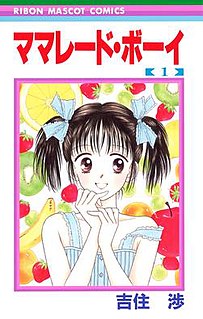
Marmalade Boy is a shōjo manga series by Wataru Yoshizumi. It was published by Shueisha in the magazine Ribon from May 1992 to October 1995 and collected in eight tankōbon volumes. The series was adapted by Toei Animation as a 76-episode anime television series which aired on TV Asahi and Fuji TV Original in 1994 to 1995 and Re-Release in 2024 to 2025. This was followed by a prequel theatrical anime movie in 1995. The series was also adapted as a 30-episode live-action television series that was broadcast in Taiwan in 2002. On mid-August 2017, the live-action film adaptation was announced. The film was released in Japan on February 27, 2018.
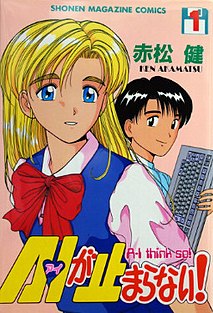
A.I. Love You is a Japanese manga series by author Ken Akamatsu. The story follows Hitoshi Kōbe, a high school guy who isn't good at anything but programming. He creates a program in particular named Program 30 which is that of a female, and is shocked when she comes to life in the real world due to a lightning storm. Hitoshi names her Saati and teaches her about the real world, while she teaches him on how to properly have a girlfriend. Things get more complex however when two more of Hitoshi's programs come to life, and a hacker goes after Saati's program. A.I. Love You was first serialized through Weekly Shōnen Magazine in 1994, but later moved to Magazine Special where it ended in 1997. The series was collected into nine manga volumes that also were released by Kodansha between 1994, and 1997. Two re-releases followed, each time though a volume was deducted.

Tokyopop, styled TOKYOPOP, and formerly known as Mixx Entertainment, is an American distributor, licensor, and publisher of anime, manga, manhwa, and Western manga-style works. The German publishing division produces German translations of licensed Japanese properties and original English-language manga, as well as original German-language manga. Tokyopop's US publishing division publishes works in English. Tokyopop has its US headquarters near LAX in Los Angeles, California. Its parent company's offices are in Tokyo, Japan and its sister company's office is in Hamburg, Germany.
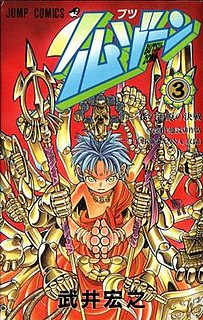
Butsu Zone is the first serialized manga by Hiroyuki Takei in Shueisha's Weekly Shōnen Jump of 1997. "Buddha Zone" is the concept by which a Buddha can appear on Earth using a Buddha statue.

Tokyo Babylon, also known as Tokyo Babylon: A Save Tokyo City Story, is a shōjo manga series created by Clamp, with story by Nanase Ohkawa and art by Mokona. The series follows Subaru Sumeragi, the head of the Sumeragi clan, and his sister Hokuto as they work to protect Tokyo from a myriad of supernatural perils. The series is based on a dōjinshi Clamp wrote but decided to add dark social themes in the serialization as a result of the chapters' length. They were published by Shinshokan in Japan from 1990 to 1993 and collected total of seven tankōbon volumes. The English-language version of the manga was first distributed by Tokyopop and is now in possession of Dark Horse Comics.
Man of Many Faces is a manga by Clamp about a nine-year-old boy named Akira Ijyuin who steals beautiful and valuable objects to please his two mothers and is known to the public as the dashing, clever thief named the Man of 20 Faces. The manga took inspiration from the works of Edogawa Ranpo, most notably from The Fiend with Twenty Faces.

Parasyte is a science fiction horror manga series written and illustrated by Hitoshi Iwaaki and published in Kodansha's Afternoon magazine from 1988 to 1995. The manga was published in North America by first Tokyopop, then Del Rey, and finally Kodansha Comics. The manga has been adapted into two live-action films in Japan in 2014 and 2015. An anime television series adaptation by Madhouse, titled Parasyte -the maxim-, aired in Japan between October 2014 and March 2015. The English-language dub aired on Adult Swim's Toonami block in America between October 2015 and April 2016.

Clover is a manga series created by Clamp, a creative team made up by Satsuki Igarashi, Nanase Ohkawa, Tsubaki Nekoi, and Mokona. The manga takes place in a dystopian future, where the government is out to control the "Clovers", a race of children with special powers.
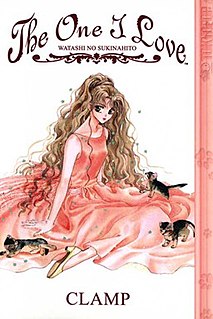
The One I Love is a romantic, slice-of-life shōjo manga by Clamp, an all-female, manga artist team consisting of Satsuki Igarashi, Mokona, Tsubaki Nekoi, and Nanase Ohkawa. Appearing as a monthly serial in the Japanese manga magazine Monthly Young Rose from December 1993 to June 1995, the twelve stories were collected into a bound volume by Kadokawa Shoten and published in July 1995. The One I Love contains twelve independent manga stories, each focusing on an aspect of love and accompanied by an essay. Ohkawa wrote the essays while Nekoi illustrated the manga; it was the first time she primarily illustrated a manga by Clamp. Some of the stories draw on the life experiences of the women while others take inspiration from conversations they had with friends.

Van Von Hunter is a weekly hand-drawn parody manga begun in 2002 by Mike Schwark and Ron Kaulfersch of Pseudomé Studio, based in Cleveland, Ohio. It has since been published in newspapers, books, and as a webcomic. The story takes place in the land of Dikay, a country fraught with undeath, and focuses on the warrior Van Von Hunter and his "never-ending fight against evil...stuff". The opening of the series and Von Hunter's presence gives the series a Castlevania-like feel, but essentially the comic spoofs role-playing games, fantasy creatures and folklore, among other things.

Speed Grapher is a 2005 anime series produced by Gonzo. The series ran for 24 episodes from April to October 2005 on TV Asahi. It tells the story of former war photographer, Tatsumi Saiga and his quest to save Kagura Tennōzu from Chōji Suitengu and the members of a fetish club, the Roppongi Club. In 2006, the series was licensed for release in North America by Funimation and aired on the Independent Film Channel between March 7 and August 15, 2008.

Tramps Like Us is a Japanese josei manga series by Yayoi Ogawa. It is about Sumire, a young professional woman who takes in a younger man as a pet, and her attempts to keep her coworkers and conventionally perfect boyfriend from finding out about her pet. It also deals with the romantic attraction between Sumire and her pet.

Alichino is a manga created by the artist Kouyu Shurei originally published in Japan by Home-sha Inc. and Shueisha. It was translated and distributed by TOKYOPOP in the United States, Canada, and the United Kingdom; the Tokyopop version of the manga is out of print as of August 31, 2009.
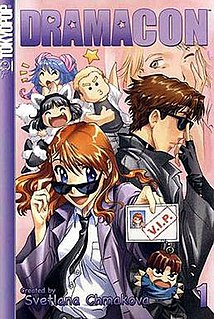
Dramacon is an original English-language (OEL) manga written and illustrated by Svetlana Chmakova. It was published in three volumes by Tokyopop from October 11, 2005 to December 11, 2007. Dramacon is considered one of Tokyopop's best OEL manga.

Mouse is a manga series written by Satoru Akahori and drawn by Hiroshi Itaba. It was serialized in the Japanese magazine Young Animal and published by Hakusensha between 1999 and 2004.
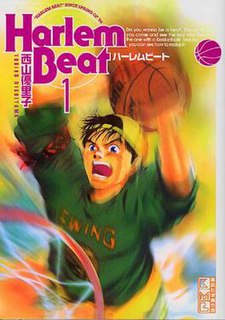
Harlem Beat is a Japanese manga series created by Yuriko Nishiyama. It was published by Tokyopop in the United States. The series contain 29 volumes in Japan. However, in the U.S., the manga goes up to 9 volumes under the name Harlem Beat, while volumes 12+ are published under the series title Rebound. As of August 31, 2009, the Rebound volumes are out of print.

Maid Sama! is a shōjo manga series by Hiro Fujiwara. It was serialized in Hakusensha's monthly shōjo manga magazine, LaLa. There are 18 published volumes under the Hana to Yume Comics imprint in Japan. At their Anime Expo 2008 panel, North American publisher Tokyopop announced its various newly licensed series and that Kaichō wa Maid-sama! would be titled Maid-sama!. A 26-episode anime adaptation produced by J.C.Staff aired between April and September 2010.

NG Life is a Japanese manga written and illustrated by Mizuho Kusanagi. It was serialized in Hakusensha's Hana to Yume from December 2005 to March 2009. The individual chapters were then encapsulated and released in nine tankōbon volumes. The series was licensed for an English-language release in North America by Tokyopop between 2008 up to 2011 when Tokyopop's North American publishing company was closed down.






















